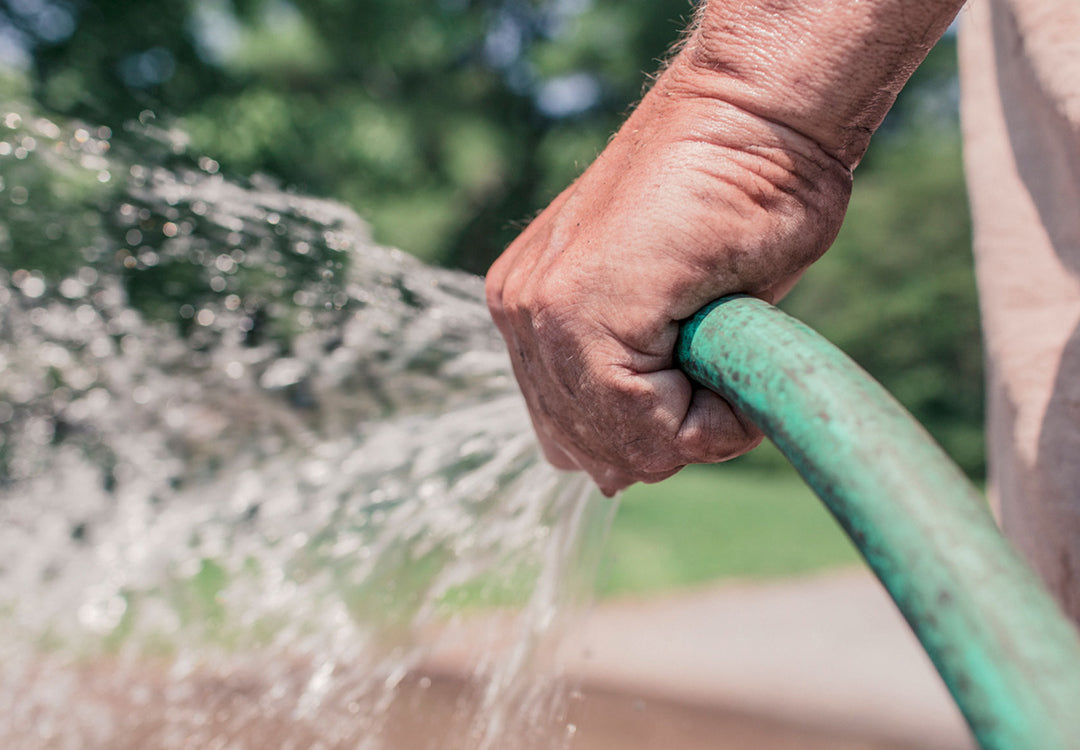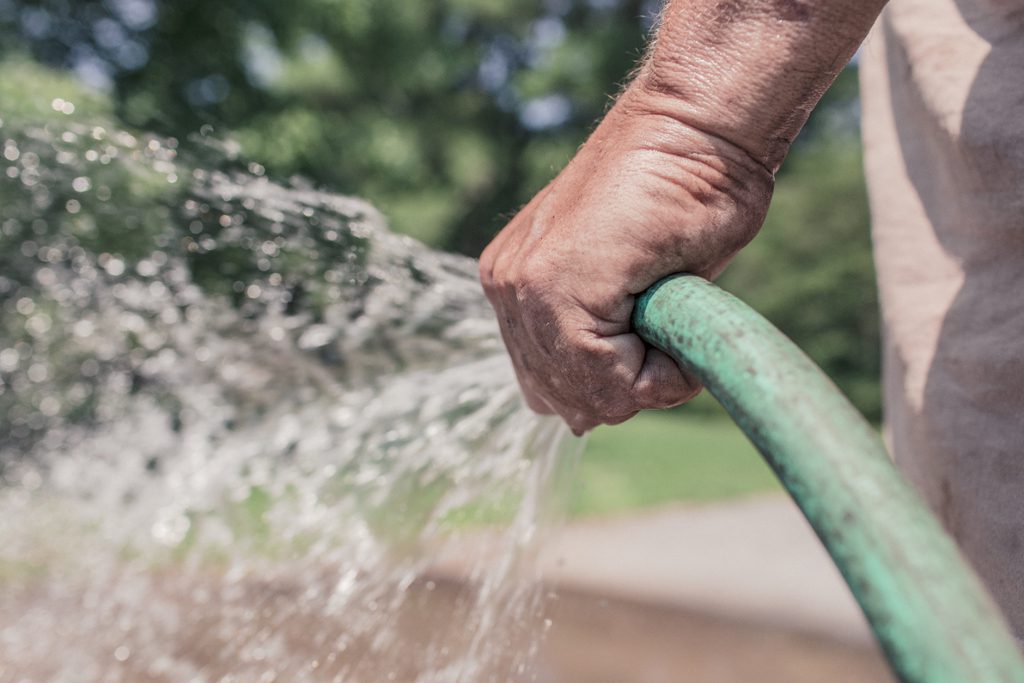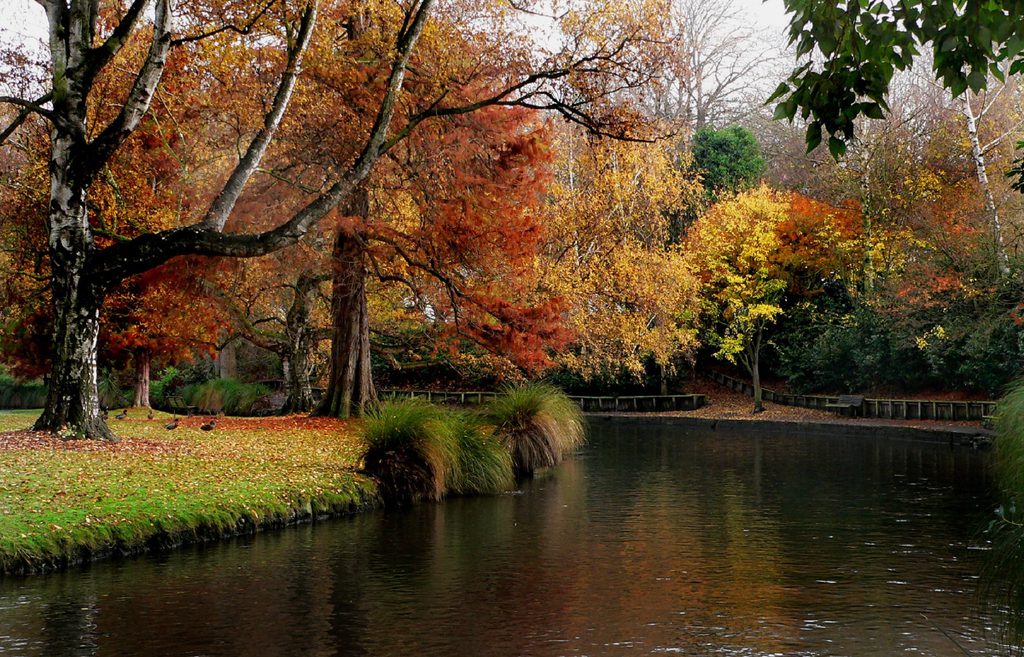
Water is a big deal for plants, which require it to perform photosynthesis and to transport sugars and important nutrients throughout the plant. Ever since their ancestors first crawled out of the ocean plants have required water and without it, they are just deadwood.

Watering with a hose is one way to do it. Image source
Roots draw the water out from below the soil surface and release it through their leaves as transpiration into the air. This water vapour is freed to move on to its next incarnation, whether that’s as rainfall thousands of kilometres away, or the condensation on your lemonade on a hot and humid day.
It is said that around 90% of the water absorbed by plants is lost through transpiration, which means they are only using about one-tenth of the water they drink for their needs, which include leaf creation, flowering, fruiting and seed germination.
Stomata are small pores in the outer layers of leaves and stems where water is lost through transpiration during photosynthesis. These stomata are operated by “guard cells” that regulate their opening and closing, and work differently in every plant.
As individual plant species each have their own watering needs, you do need to know the amount each of your plants needs. A tropical plant will clearly need more water than a desert-dweller due to the environment its ancestors evolved within.
That’s why organising your plants into guilds of plants with complimentary needs is a good idea: you can tend to plants that have the same watering needs together. Having plants with different water needs mixed in together can be difficult to manage.
It’s best to water in the morning most of the time, because the leaves have time to dry before night time. Wet leaves at night encourage mold, whereas watering in the morning lets them dry out during the day. There are exceptions to this rule, for example in the case of freshly laid turf, which needs to be watered several times a day to avoid drying out, mold be damned!
Established trees often have roots that go deep enough to get access to water that smaller shrubs can’t reach. Because of this, established trees usually don’t need to be watered at all and should be able to survive off the normal rain that falls through the year as long as they’ve been planted in the right place. Saplings and trees that have been planted less than a year ago are a different story and need constant water until they establish themselves properly.
Water your plants in the garden by emulating good, soaking rain. Use a watering can or spray function on your hose nozzle to disperse the water and soak slowly. Dumping 10L bucket of water onto the soil or using the jet function on the nozzle is less effective at fully soaking the soil and is likely to encourage water to roll of the soil surface and disturb the topsoil. If you don’t have a nozzle for your hose, you can use your thumb to block it create a nice spray effect.
Alternatively, there are a variety of sprinkler systems out there, from simple manual options that you turn on and off yourself, to fully automated digital systems that you control out of an app on your phone.
Indoor plants can be a bit harder to water. As you pour water into the top of a pot, the water can find shortcuts through the soil and make its way to the base without fully soaking all of the soil. To avoid this, you can soak the pots in a bath or a tub (I use a washing basket), and let it sit for a while so it can fully soak. You might see bubbles rising for quite a while, especially if the soil is compacted.
After a few minutes, take the pot out and let it drain. Make sure you use pots with drainage holes so your plant doesn’t drown, you let most of the water drain before putting the plant back in it’s home. Once it’s on its usual shelf, the pot needs a tray to sit under it so that water doesn’t drain out all over your house.
Some plants, especially certain indoors, don’t do well with tap water due to the chlorine. Rainwater and filtered water are much healthier for plants though not always practical. Distilled/demineralised water can be purchased at your local store without any nasty chemicals, however adding minerals back into it is recommended as plants do need those nutrients.
4 Ways To Test If You’re Under Or Over-Watering Your Plants
Your plants are looking sick and you don’t know whether they are getting too much or too little water. Or, you’ve just bought a pot plant and want to know how much water to give it. Resist the urge to go ahead and give it another drenching and let’s take a more measured approach.
1. First, you’re going to want to Google the species and check its specific water needs. Some plants, like certain tropical species, require constant water, whereas others, like cacti and succulents, prefer to be seated in a dry bed most of the time. Be careful to clump appropriate plants when planning your garden so that plants from similar climates with similar water needs are clumped together.
2. Consider the conditions. Is it winter, and your garden will hold onto the water it receives for weeks, or are you in summer with dry heat plus very little rain and moisture is quick to evaporate? Adjust your watering habits with the seasons.
3. Physically test the soil moisture. Stick your finger deep in the soil and have a feel. Look at the dirt that is stuck to your fingers: is it bone dry or is it a little bit moist? If the soil is actually wet without being recently watered, you may have gone too far with the watering and your poor plant may drowning.
A more accurate way to test soil moisture than using your finger is a horticultural moisture meter, which you can stick into the ground and get a moisture reading.
If it’s in a pot, you can clean the bath or laundry sink and fill it up just high enough that the pot is submerged but not much of the trunk is. Leave it for a few minutes, and then drain the water from the sink and allow the pots to also drain for a few more minutes. Use pots that allow the water to drain from the soil, not the type without holes.
4. Check for clues in the leaves. If they are looking discoloured or are dying but staying stuck to the branch, this can be a sign that your poor plant is drowning. If the leaves are going soft and limp, even falling off, this can also be a sign of overwatering. If the leaves are dry and falling off (crispy, not soft), he and/or she (plants can be either or both genders) might be drying out.
Another issue caused by overwatering is edema, where the plant takes up more water than it transpires. Bumpy foliage, blisters or water-soaked leaf undersides are signs of edema.
Remember that there are many symptoms that look similar. Chlorosis, meaning yellowing of the leaves as the plant draws back chlorophyll (a green pigment that plants use to photosynthesise), can occur as a result of both over and under-watering. Or to give another example, there might be an abundance of water in the ground but the plant has a girdling root*, which strangles the plant, choke off the flow of water and starves it of water making the leaves go crispy and fall off.
Hopefully, this gives you the tools you need to assess how much water your plants need. If they have been suffering lately, try changing your watering habits to see if that is the problem. Also give your plants a seaweed solution like SeaSol as a health treatment to help them recover more efficiently, either applied to the foliage or the roots, and fertilise appropriately to make sure your plants have plenty of nutrients.
Drainage
Whether your plant lives in a pot or in a garden bed, it almost certainly requires drainage so that it doesn’t drown.
Believe it or not, plants intake oxygen through their roots, in addition to the carbon dioxide that they take in through their leaves. They also expel oxygen through the leaves during photosynthesis, but that takes place in the leaves as opposed to the roots.
Too much water in the soil means that plants can’t intake oxygen, root rot and disease may take hold, and eventually, your plants will experience an unfortunate case of death.
Sandy soil is very well-draining, whereas clay is not well-draining at all. Healthy, loamy soil hits the sweet spot between clay and sand and is a combination of clay, silt and sand, and different sized soil particles leave spaces for air, water to flow freely, and allow roots to penetrate deeply and feed on the nutrients in the suspended water.
It retains some moisture for the plants to use, but drains well enough to allow them to breathe. Having plenty of organic compost and humus help retain the right amount of water without blocking the movement of moisture, like a sponge.
Ensure your potted plants have drainage holes at the bottom. You need to include a tray below the pot so that the water doesn’t leak all over your balcony leaving traces of dirt when the puddle dries.
It can be hard to find stylish pot trays to match your pots. Some manufacturers don’t make them due to the fact they break so easily, so it’s a bit of a pain. You can find clear plastic ones for cheap which will hopefully blend in.
If you need to break apart clay soil in your garden, you can use a clay breaker in the short term and add compost for the long term. Biochar and gypsum sand will aid the compost in building a healthy soil moving forward into the future. Also avoid compacting the soil further by driving your car over it.
Sometimes. for example if you live on a river or a lake, the ground may never really get dry no matter the size of the soil particles.

Right plant right place: trees that love lots of water should be planted in soil that stays wet, such as near a body of water. Image source
If your garden soil has poor drainage or you are planting along a river, you will need to select the type of plants that thrive in those conditions, for example certain members of the willow, ash, oak or acer families.
Where To From Here?
Watering plants is said to be the most common problem when it comes to plant health issues. But don’t let the learning end here! Let’s keep this party going.
Or why not brush up on a bit of plant biology and learn about the plant system that is responsible for transporting water (and sugar) from the roots to the leaves: the vascular system.
Soil issues are key to solving problems with watering plants, whether they aren’t able to access enough of it or if it’s trapped around their roots. You can learn about soil health here.
